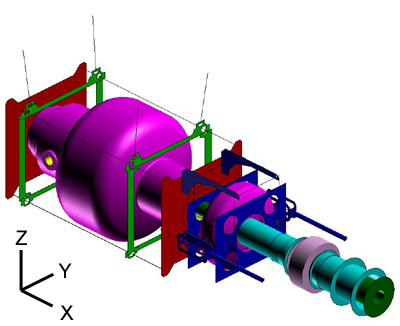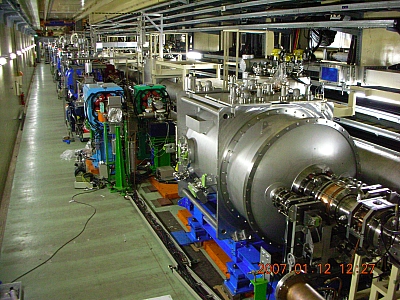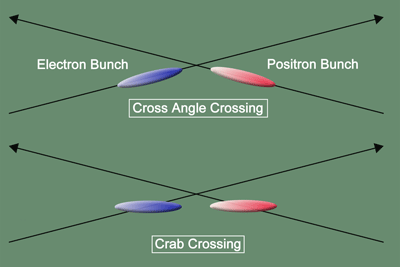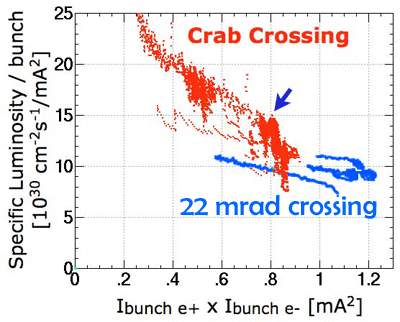A team of accelerator physicists at the High Energy Accelerator Research Organization (KEK) in Tsukuba, Japan, has achieved effective head-on collisions of electrons and positrons using new devices called "crab cavities" during the spring operation period of the KEKB accelerator. This success will pave the way to increase KEKB's luminosity, which is already the world highest, to an unprecedented level.
At KEKB, beams of electrons and positrons collide at nearly the speed of light and annihilate into a state of pure energy. These collisions produce pairs of particles called B mesons and anti-B mesons. These mesons have several thousand decay modes; therefore, it is essential for the experiment to have as many pairs as possible. The rate of collisions, called luminsity, is the most critical parameter for the successful operation of KEKB.
The electron and positron beam bunches cross at an angle of 1.3 degrees at KEKB. This non-zero crossing angle is one of the novel design features of KEKB, providing effective beam separation at the collision point without a high level of background noise in the detector. To boost the luminosity further, it is necessary to tilt the bunches of electrons and positrons for effective head-on collisions while retaining the crossing angle.
To accomplish this goal, the KEK researchers built several superconducting radio-frequency cavities or "crab cavities" that tilt each bunch sideways (somewhat akin to the way a crab walks) so that they collide head-on at the interaction point. At low currents, the crab cavities achieved a tune-shift comparable to the world record. Tune-shift is a quantity proportional to the luminosity divided by the product of beam currents and is a measure of luminosity potential. Recently, at high beam currents (1300 mA in the low energy positron beam and 700 mA in the high energy electron beam), they were able to operate at a luminosity above 1034/cm2/sec. These results from the first round of commissioning demonstrate the potential of the crab cavities, which according to simulations may eventually improve the luminosity by a factor of two. More commissioning runs and R&D will enable further increase of the performance.
The concept of crab cavities was first suggested almost 30 years ago by R. Palmer for linear electron-positron colliders. In 1989, K. Oide and K. Yokoya proposed the use of crab cavities in storage rings. This was followed by designs and prototype models of the crab cavity by K. Akai as part of a collaboration between the KEK and Cornell laboratories around 1992. Detailed engineering and prototyping were done at KEKB by K. Hosoyama's team. The first full-size cavities were developed and installed in January 2007. Commissioning at KEKB started in February 2007 and continued until the end of June.
The KEKB collider is used by researchers for studies of matter-antimatter asymmetry with beauty (b) quarks and searches for new physics by the Belle experiment, a collaborative international effort of scientists from universities and research institutes. The Belle experiment has reported a number of fundamental discoveries concerning matter-antimatter asymmetry and rare decays.
For the future, a super B Factory that will use crab cavities for higher luminosities is under discussion. Such a machine has the potential to discover physics beyond the Standard Model in rare decays. Crab cavities will also play a role in achieving high luminosity at other machines with a crossing angle, including the International Linear Collider (ILC), upgrades of the Large Hadron Collider (LHC) at CERN as well as future synchrotron light sources.
[ Media Contact ] Youhei Morita, KEK Public Relations Office
+81 29-879-6047
|
 |
| Figure 1 : A CAD drawing of a crab cavity |
 |
| Figure 2 : A photograph of a crab cavity in the KEKB collider |
 |
| Figure 3 : Crab cavity enables the tilted collisions of electron and positron beam bunches. |
 |
Figure 4 : This figure shows the luminosity per bunch divided by the product of bunch currents. The red points show the results with crab cavities while the turquoise points show collisions without the crab cavities. A clear improvement is visible, especially at low bunch currents. The beam-beam tune shift reached a record value of 0.088 near the location of the arrow. |
|



